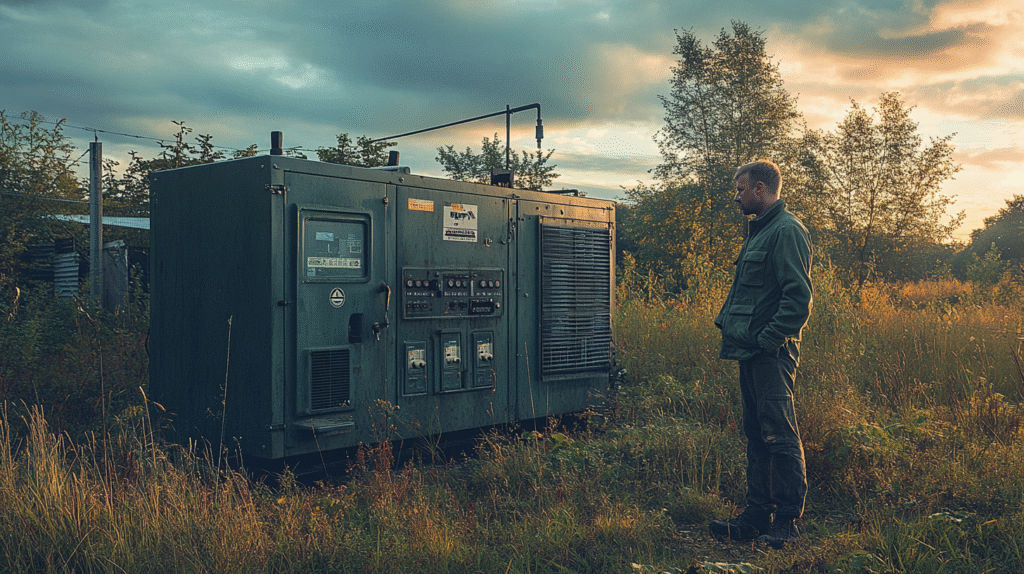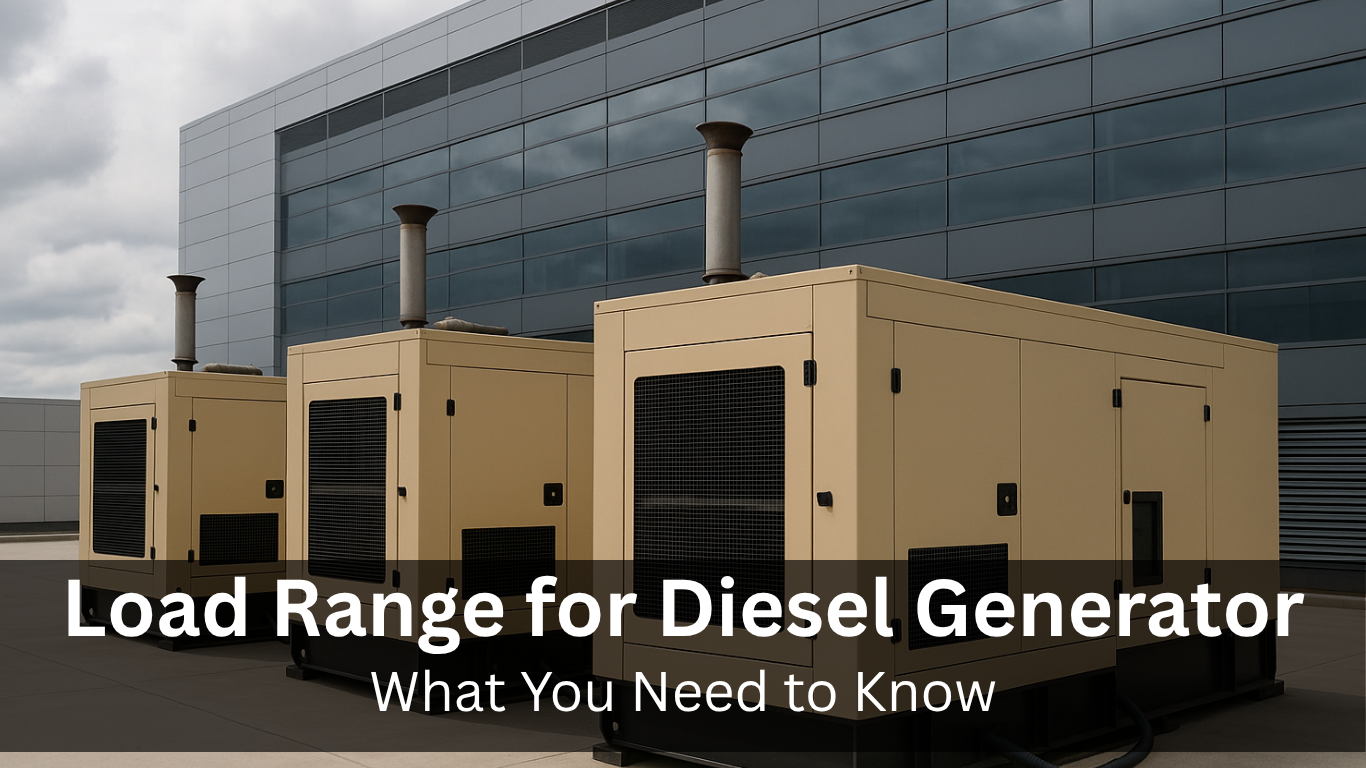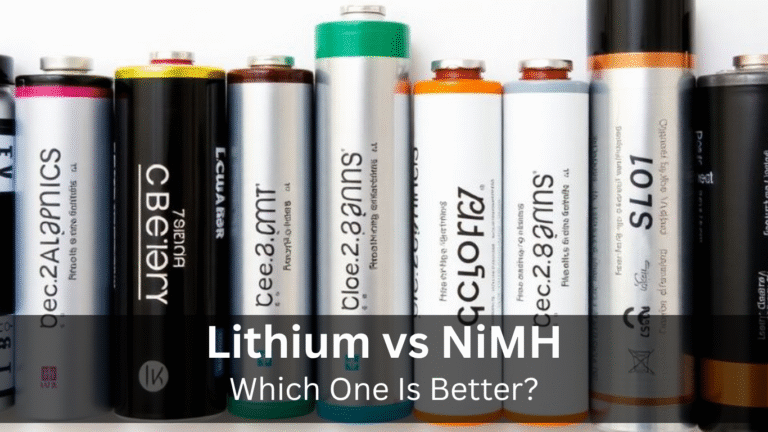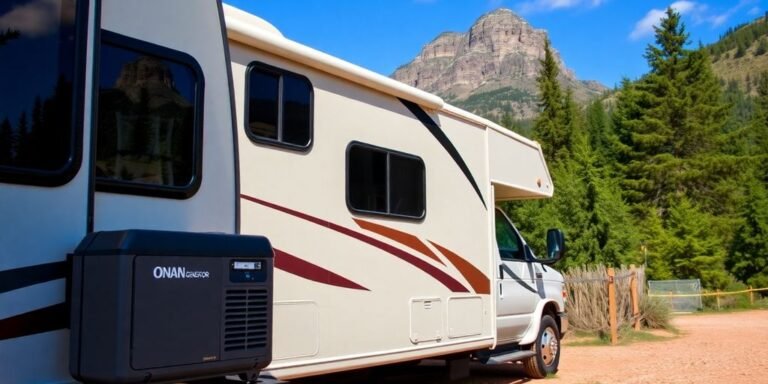Optimal Load Range for Diesel Generator: What You Need to Know
Ever wondered when your diesel generator is really pulling its weight, or when it’s just burning through fuel for no good reason? It’s a common question, and getting the answer right can save you a lot of money and headaches. We’re going to dig into what makes a diesel generator efficient, especially when it comes to how much load you put on it. Understanding the sweet spot for your diesel generator‘s workload is key to making it last longer and run better. Let’s figure out how to get the most out of your machine.
Key Takeaways
- Diesel generators usually work best and use fuel most efficiently when running at about 70-80% of their full power.
- Running a generator at a very low load for too long can cause “wet stacking,” where unburned fuel builds up and can damage the engine.
- Matching the generator’s size to what you actually need is super important; an oversized generator wastes fuel and can lead to problems.
- Regular check-ups and maintenance help keep your generator running smoothly and efficiently, saving you money on fuel and repairs.
- Factors like how hot or cold it is outside, how high up you are, and the quality of your fuel can all change how efficient your generator is.

Understanding Diesel Generator Load Efficiency
Optimal Operating Ranges
Okay, so when we talk about diesel generators, it’s not just about turning them on and hoping for the best. The load you put on a generator seriously affects how well it runs and how much fuel it burns. Think of it like driving a car – you don’t get the best gas mileage flooring it all the time, right? Same deal here. Diesel generators have sweet spots, usually somewhere between 50% and 80% of their maximum capacity for standby and prime power units.
Continuous diesel generators like to run a bit higher, around 70% to 100% of their total load rating. Staying within these ranges helps keep things efficient and prevents problems down the road. It’s all about finding that Goldilocks zone where the generator is working hard enough to be efficient but not so hard that it’s straining itself.
Impact of Light Loads
Running a diesel generator on a light load for too long? That’s a recipe for trouble. It’s like making the engine idle for hours; it just wasn’t designed for that. One of the biggest issues is something called “wet stacking.” Basically, the engine doesn’t get hot enough to fully burn the fuel, and that unburnt fuel ends up gunking up the exhaust system. This can lead to:
- Contaminated fuel injectors
- Carbon buildup in the exhaust
- Reduced overall efficiency
Think of it as cholesterol for your generator – it clogs things up and makes it harder for everything to work properly. So, avoid letting your generator loaf around at low loads for extended periods. You want to keep those operating temperatures up to avoid generator and control solutions issues.
Risks of Overloading
On the flip side, you don’t want to push your generator too hard either. Overloading a diesel generator is like constantly redlining your car’s engine – it’s going to cause damage over time. If you consistently operate above 100% of its rated capacity, you’re shortening its lifespan and risking serious engine damage.
It’s better to have a generator that’s slightly larger than you need than one that’s constantly struggling to keep up. A good rule of thumb is to calculate your total power needs and then consider a slightly larger generator for better reliability. Some customers have even replaced oversized generators with two synchronized units to better match their load profile, reducing fuel use by around 15% annually. Here’s a quick rundown:
- Reduced lifespan
- Increased risk of breakdowns
- Potential for permanent damage
Operating a generator outside of its optimal load range, whether too low or too high, can lead to increased fuel consumption, maintenance costs, and potential damage. It’s important to understand the specific requirements of your equipment and match the generator size and load accordingly.
Fuel Consumption at Various Load Levels

Okay, so let’s talk about how much fuel these diesel generators actually burn, and how that changes depending on how hard they’re working. It’s not as simple as “more work = more fuel” – there’s a sweet spot. Understanding this can save you a lot of money and headaches.
Typical Fuel Consumption Rates
The amount of fuel a diesel generator uses depends on a few things: how big it is, how much load it’s carrying, and how efficient the engine itself is. On average, you’re looking at somewhere between 0.2 and 0.4 liters of fuel per kWh. But that’s just a general idea. To get a better handle on it, let’s look at some typical consumption rates at around 75% load. This is where generators tend to be most efficient. Check out these diesel generator benefits.
Efficiency at Partial Loads
Running a generator at a light load might seem like a good way to save fuel, but it can actually be worse in the long run. A lightly loaded generator can waste fuel and cause damage over time. Overloaded units burn fuel inefficiently and stress the engine. Generators are most efficient between 70% and 80% of their rated load. Here’s a quick look at how load levels affect fuel consumption:
| Load Level | Typical Fuel Consumption (Liters/kWh) | Efficiency Impact |
|---|---|---|
| 25% Load | 0.4 – 0.6 | Low efficiency |
| 50% Load | 0.3 – 0.4 | Moderate efficiency |
| 75% Load | 0.25 – 0.35 | Optimal efficiency |
| 100% Load | 0.3 – 0.4 | High wear and risk |
Real-World Data Insights
Numbers are great, but what about real-world examples? Here’s some data showing fuel consumption at 75% load for different generator sizes. Keep in mind that these are averages, and things like fuel quality, temperature, and altitude can all play a role. Real-world data helps you estimate costs more accurately.
| Generator Size | Fuel Consumption (Liters/hour) at 75% Load |
|---|---|
| 20 kVA | 4.5 – 5.5 |
| 50 kVA | 8 – 10 |
| 100 kVA | 17 – 20 |
| 250 kVA | 38 – 45 |
| 500 kVA | 75 – 85 |
| 1000 kVA | 150 – 165 |
I always tell people to test their generators under actual conditions. Lab tests are a good starting point, but you need to see how it performs when it’s doing real work. A customer once replaced a single oversized generator with two synchronized units that matched their load profile. The result? They reduced fuel use by about 15% annually while achieving more stable performance.
Preventing Wet Stacking and Engine Damage
Causes of Wet Stacking
Okay, so wet stacking is a real problem with diesel generators, and it happens when the generator isn’t working hard enough. Basically, the engine doesn’t get hot enough to fully burn all the fuel. This is more common when a generator is running at a low load for extended periods. Think of it like this: you’re not giving the engine a good workout, so it starts to get lazy. The unburnt fuel then starts to accumulate in the exhaust system. This is especially common in construction light towers, where the load can vary significantly. Understanding the causes of wet stacking is the first step in preventing it.
Consequences of Unburnt Fuel
So, what’s the big deal with unburnt fuel? Well, it can cause a whole host of problems. First off, it can contaminate the fuel injectors, which means they won’t spray fuel as efficiently. This leads to even more unburnt fuel and a downward spiral. The unburnt fuel also leads to carbon buildup in the exhaust, turbocharger (if equipped), and valves. This buildup can reduce the generator’s power output and overall efficiency. Over time, it can even cause serious engine damage, requiring expensive repairs or even replacement. It’s like cholesterol building up in your arteries, but for your generator. Regular load bank testing can help prevent this.
Maintaining Optimal Operating Temperatures
So, how do you prevent wet stacking and engine damage? The key is to make sure your generator is running at the right temperature. Here are a few things you can do:
- Run the generator at a sufficient load: Aim for at least 30% of the generator’s rated capacity. If your load is consistently low, consider using a smaller generator or adding a load bank to increase the load.
- Regularly perform load bank testing: This involves running the generator at its rated capacity for a period of time to burn off any accumulated fuel and carbon deposits.
- Ensure proper ventilation: Make sure the generator has adequate airflow to prevent overheating. Overheating can also cause engine damage, so it’s important to strike a balance.
Maintaining optimal operating temperatures is crucial for preventing wet stacking and engine damage. Regular maintenance, proper load management, and using high-quality fuel are all important factors in keeping your generator running smoothly and efficiently.
Matching Generator Size to Demand
It’s easy to think bigger is better when it comes to generators, but that’s not always the case. Getting the right size generator for your needs is super important for efficiency and preventing damage. I remember one time, a company I worked with bought a massive generator thinking it would cover any future expansion. Turns out, they were mostly running it at like 20% capacity, which caused a whole host of problems.
Importance of Right-Sizing
Right-sizing the generator ensures better fuel efficiency and less mechanical stress. It’s all about matching the generator’s output to your actual power needs. If you’re constantly running a generator at a fraction of its capacity, you’re wasting fuel and potentially causing engine problems. Think of it like driving a huge truck to pick up a single grocery bag – overkill, right? Choosing the correct generator sizes is crucial for optimal performance.
Avoiding Oversized Generators
Oversized generators can lead to a few issues:
- Wet stacking: This happens when unburnt fuel accumulates in the exhaust system because the engine isn’t running hot enough to burn it off completely. It’s bad news for the engine.
- Reduced fuel efficiency: Generators are most efficient when running closer to their rated capacity. An oversized unit will burn more fuel than necessary.
- Increased maintenance costs: Wet stacking and other issues caused by underloading can lead to more frequent and costly repairs.
Running a generator at very low loads is like constantly idling your car – it’s not good for the engine and wastes fuel. You want to find that sweet spot where the generator is working efficiently without being overloaded.
Benefits of Synchronized Units
One way to handle varying power demands is to use synchronized generator units. Instead of having one large generator that’s often underutilized, you can have multiple smaller generators that can be brought online as needed. This allows you to match the power output to the demand more closely, improving efficiency and reducing wear and tear. Plus, if one unit needs maintenance, the others can pick up the slack, ensuring continuous power supply. It’s a more flexible and efficient approach for many applications. Here’s a quick look at how fuel consumption changes with load:
| Generator Size (kW) | 50 Percent Load | 75 Percent Load | 100 Percent Load |
|---|---|---|---|
| 8 | 0.39 gal/hr | 0.54 gal/hr | 0.69 gal/hr |
| 10 | … | … | … |
Optimizing Diesel Fuel Consumption
It’s a pain when you realize how much fuel these generators guzzle. You can’t really control fuel prices, but you can control how efficiently you use your diesel generator. It’s all about getting the most bang for your buck, right?
Practical Tips for Efficiency
Here are some things I’ve learned over the years that can really make a difference:
- Right-size your generator. This is huge. Don’t get a massive generator if you only need a small one. Match the generator’s capacity with your actual load demand. It’s like buying the right size shoes—too big, and you’re just wasting energy.
- Load bank testing. Regular testing helps avoid issues like wet stacking. It’s like giving your generator a check-up to make sure everything’s running smoothly. This helps with energy management.
- Preventive maintenance. Keep those filters clean, check the injectors, and monitor the coolant system. Think of it as giving your generator a spa day—it’ll thank you for it.
Proper load management, preventive maintenance, and even engine tuning can make a big difference. It’s not just about saving money; it’s about making your equipment last longer and run better.
Role of Proper Load Management
Load management is all about making sure your generator isn’t working too hard or not hard enough. Ideally, you want it running at that sweet spot, usually around 70-80% of its rated load. Here’s a quick look at potential fuel savings:
| Practice | Fuel Savings Potential | Notes |
|---|---|---|
| Load management | 5% – 10% | Reduce underloaded run time |
| Regular maintenance | 3% – 5% | Keep engines clean and tuned |
| Real-time monitoring | 2% – 4% | Identify problems early |
Benefits of Preventive Maintenance
Preventive maintenance is more than just changing the oil. It’s about catching small problems before they become big ones. Regular maintenance can extend the life of your generator and keep it running efficiently. It’s like going to the doctor for a check-up—it’s better to catch something early than to wait until it’s a crisis. Here’s a table showing typical fuel consumption for different generator sizes:
| Generator Size | Fuel Consumption (Liters/Hour) |
|---|---|
| 100 kVA | 17 – 20 |
| 250 kVA | 38 – 45 |
| 500 kVA | 75 – 85 |
| 1000 kVA | 150 – 165 |
Factors Influencing Fuel Efficiency
Diesel generator fuel efficiency isn’t just about the engine itself; several external factors play a significant role. Let’s look at some of the key things that can impact how much fuel your generator burns.
Ambient Temperature Considerations
Temperature can really mess with a generator’s performance. Extreme temperatures impact generator performance generator performance. High heat reduces air density, which means less oxygen for combustion, and that lowers efficiency. On the flip side, really cold weather can cause diesel fuel to thicken or even gel, making it harder to pump and burn properly.
- High temperatures reduce air density, decreasing combustion efficiency.
- Low temperatures can cause fuel gelling, affecting fuel flow.
- Maintaining proper ventilation can help regulate temperature around the generator.
Altitude Effects on Performance
Altitude is another sneaky factor. The higher you go, the thinner the air gets. This means less oxygen is available for combustion, just like with high temperatures. Generators might need to be derated at higher altitudes to compensate for this, which means they produce less power for the same amount of fuel. Altitude definitely plays a role.
At higher altitudes, the air is less dense, leading to incomplete combustion and reduced power output. This can increase fuel consumption as the engine works harder to maintain the required power levels. Adjusting the fuel-air mixture or using a turbocharger can help mitigate these effects.
Fuel Quality Impact
The quality of your diesel fuel matters a lot. Using low-quality fuel can lead to incomplete combustion, which means wasted fuel and increased emissions. It can also cause deposits to form in the engine, leading to maintenance problems down the road. Always use fuel that meets the manufacturer’s specifications. You can optimize diesel fuel consumption by using high quality fuel.
- Low-quality fuel can cause incomplete combustion.
- Contaminants in fuel can damage engine components.
- Using the correct fuel type as specified by the manufacturer is crucial.
Generator Types and Their Efficiency

Standby and Prime Power Generators
Standby generators are designed for infrequent use, kicking in only when the main power source fails. Because they aren’t used constantly, their efficiency isn’t always the primary focus, but it’s still important. Prime power generators, on the other hand, are intended for continuous or frequent use, making their fuel efficiency a much bigger deal. Prime power units often have features that optimize fuel consumption, since they’re expected to run for extended periods. It’s worth looking into generator efficiency if you rely on these often.
Continuous Diesel Generators
These generators are built to run non-stop, providing a consistent power supply. Because of this, they’re engineered for optimal fuel efficiency and durability. Manufacturers often incorporate advanced technologies to minimize fuel consumption and reduce wear and tear. Regular maintenance is key to keeping these generators running efficiently over their lifespan. Here are some things to keep in mind:
- Proper cooling systems are essential.
- Fuel filtration is critical for continuous operation.
- Scheduled inspections prevent downtime.
Inverter Generator Efficiency
Inverter generators offer a different approach to power generation. They produce AC power, then convert it to DC, and finally invert it back to AC at the desired voltage and frequency. This process allows them to vary engine speed based on the load, which can significantly improve fuel efficiency, especially at lower power levels. However, they may still struggle with efficiency at very low power settings. Inverter generators are often smaller and quieter than traditional generators, making them a good choice for applications where noise and portability are important.
Inverter generators are generally more efficient than traditional generators, especially at partial loads. This is because they can adjust their engine speed to match the power demand, reducing fuel consumption when less power is needed. However, at full load, the efficiency difference may be less significant.
Conclusion
So, what’s the big takeaway here? Basically, your diesel generator is happiest and most efficient when it’s working pretty hard, but not too hard. Think of it like a car on the highway – it gets the best gas mileage when it’s cruising at a steady speed, not when it’s stuck in stop-and-go traffic or redlining.
Running a generator at a really low load for a long time can cause problems like “wet stacking,” which is just a fancy way of saying unburned fuel messes things up inside. And pushing it too hard, over its limit, is also a bad idea. The sweet spot is usually somewhere around 70-80% of its total power. Keeping your generator in this range means it uses less fuel, lasts longer, and generally just works better. It’s all about finding that right balance to keep things running smoothly and save you some cash in the long run.
Frequently Asked Questions
At what power level does a diesel generator run most efficiently?
Diesel generators typically work best and use fuel most efficiently when they are running at about 70% to 80% of their full power. This sweet spot helps them burn fuel completely and avoid problems.
What happens if a diesel generator runs at a very low power for too long?
Running a generator at a very low power for too long can lead to something called “wet stacking.” This happens when the engine doesn’t get hot enough to burn all the fuel, causing unburnt fuel and carbon to build up in the exhaust system. This can hurt the engine over time.
How can I estimate how much fuel my diesel generator will use?
To figure out how much fuel your generator will use, you need to know its size and how much power you’re asking it to make. Generally, a generator uses more fuel as you ask for more power. You can often find charts that show estimated fuel use for different generator sizes at various power levels.
Does the size of the generator affect how well it uses fuel?
Yes, the size of your generator really matters for how well it uses fuel. If your generator is much bigger than what you actually need, it will often run at a low power setting, which is less efficient and can cause problems like wet stacking. It’s better to pick a generator that closely matches your power needs.
What are some ways to make my diesel generator use less fuel?
You can make your diesel generator use fuel more wisely by making sure it’s not too big for your needs, running it within its best power range (usually 70-80%), and keeping up with regular check-ups and maintenance. Also, using good quality fuel helps a lot.
Are the fuel consumption numbers listed by manufacturers always accurate?
While lab numbers are a good start, the best way to know your generator’s true fuel use is to test it in your actual situation. Things like how hot or cold it is outside, how high up you are, and the quality of your fuel can all change how much fuel it burns.









5 Comments